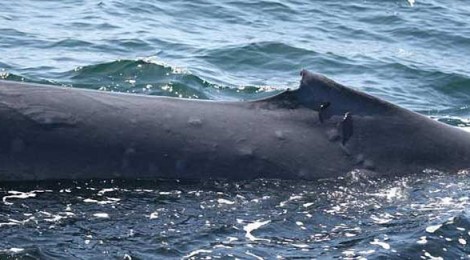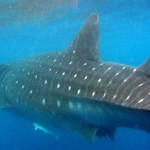The following post is authored by Catharine Chen as part of the Sizing Ocean Giants project. This post originally occurred on the Story of Size.
Adapted from Just So Stories by Rudyard Kipling.
Long, long ago, there was a Blue Whale (Balaenoptera musculus) who ate everything in the ocean but a small fish. Fearing for his life, the fish hid behind the Whale’s ear and said, “Noble and generous Cetacean, have you ever tasted Man?”
“No,” said the Whale. “What is it like?”
“Nice. Nice but nubbly.”
Wait, what? Jane Austen taught me that folks in the 19th century all have elegant and dignified speech, but nubbly sounds like gibberish. A word a two year-old would babble out. Alright, fine, the dictionary says it means “coarse or knobbly in nature,” but I, as a member of H. sapiens, am for one certainly not nubbly. For real nubbles, just check out our lovely blue whale protagonist:

Credits Diane Gendron, Associated Press.
Ick. Now that’s knobbly and just generally kind of gross looking. Technically those lumps are skin lesions, or as we more commonly refer to them, sunburns. Poor fellows; it’s pretty hard to protect yourself from the sun when you’re hanging out on the surface of what’s essentially a really huge pool. However, it turns out that blue whales have come up with a pretty good strategy for dealing with that problem.

From Martinez-Levasseur et al., 2013.
The scientists took photos of the whales’ epidermises, and calculated the total area of each of the grey dots, or the melanin. They found that when the whales migrated south to the sunny Gulf of California, their melanin amounts increased, and when the whales moved back to their northern feeding grounds, the melanin correspondingly decreased. The researchers also found that the higher the melanin amounts, the less the whale’s mitochondrial DNA was damaged, and the fewer skin lesions it had. And what does a melanin increase lead to? Darker skin! Essentially, blue whales protect themselves from UV’s harmful effects by getting tan, just like us. And Snooki.

Credits adrianropp, Flickr.
Besides opening the door to endless bad “beached whale” puns, this finding not only proves that blue whales have a way to protect themselves from UV damage, but also raises the questions of what levels and intensities of UV could overcome this defense and become the lesions we saw, and when those lesions would in turn lead to cancer. With increasing UV hitting our whales – and us! – should we be concerned?
Tumors and nubbles aside, let’s return to our tale:
The fish gave the Whale directions to find a Man: “Swim to 50N and 40W, where you will find a man sitting on a raft in the middle of the sea.”
The Whale hurried to the point, where a man named Henry sat upon the water, wearing a new pair of blue breeches, suspenders and holding a knife. The Whale opened his mouth as wide as he could and swallowed Henry whole.
But Henry was clever: he began jumping and leaping and dancing and hitting the Whale from the inside. The Whale groaned and moaned and hiccuped. (Despite being titled “relaxing,” that sounds an awful lot like hiccupping to me.)
The Whale opened his mouth:
“Henry, won’t you come out?”
“No!” said Henry. “I’ll come out if you take me to the shore.”
So the Whale swam as quickly as he could. He rushed onto the shore of Henry’s home, and opened his mouth. However, as the Man left, the Whale was very rudely surprised indeed.
Henry had cut his raft into little pieces, tied them into a grate with his suspenders, and as he walked out, jammed the contraption into the Whale’s throat!
From that day on, the Whale has had a blocked throat, and wants to eat people – but can’t!
Cute. Too bad the blue whale’s huge plates of baleen didn’t really come from an encounter with a man, but they are pretty cool in their own right. Blue whales are actually a type of mysticetes, or “moustached whale,” who all use baleen to filter their food from the water.

The real baleen is far more sturdy than raft parts tied together by suspenders. It is made up of keratin, the same material as our fingernails, and looks something like this:
Blue whales use their baleen to feed on krill, and employ an extremely energy intensive method. They dive deep beneath the water, quickly lunge upwards with their mouths open, and then push the water in their mouths through the baleen, leaving only the krill behind. By performing this behavior in areas with extremely high concentrations of krill, this lunge-feeding pattern becomes sustainable for the whales. So Henry aside, we really wouldn’t have to worry anyway: if blue whales lunge-fed just for one measly human, the payoff would just not be worth it.
So, as Kipling said, “that is the end of that tale.”
For more check out:
- Whales Use Distinct Strategies to Counteract Solar Ultraviolet Radiation on whale tanning
- Mechanics, hydrodynamics and energetics of blue whale lunge feeding: efficiency dependence on krill density on blue whale feeding behavior
- And the original How the Whale Got His Throat (1902) from Rudyard Kipling







2 Replies to “How the Whale Got His Throat and Other Musings by a Nubbly Human”
Comments are closed.